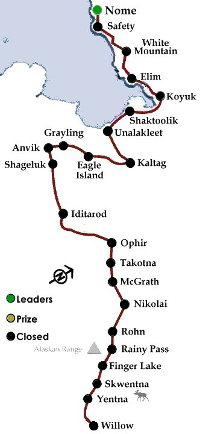Iditarod 2019 – Day 5

 After 14 hours Nic changed his mind and hit the trail. Many others are beginning to take their 24-hour stops at Takotna.
After 14 hours Nic changed his mind and hit the trail. Many others are beginning to take their 24-hour stops at Takotna.
Shaynee Traska (7) has scratched at Nikolai. A lot of people got beat up by the trail from Rohn, which is not unusual.
Standings at 10:15 PM CST:
Beyond Ophir
1 Aliy Zirkle (19)
2 Martin Buser (21)At Ophir
3 Nicolas Petit (20)
4 Jessie Holmes (5)
5 Aaron Burmeister (38)
6 Anna Berington (10)
7 Kristy Berington (26)
At Takotna
8 Joar Leifseth Ulsom (28)
9 Jessie Royer (14)
10 Peter Kaiser (9)
11 Matt Hall (3)
12 Richie Diehl (29)
13 Ryan Redington (22)
14 Mitch Seavey (32)
15 Matthew Failor (17)
16 Paige Drobny (40)
17 Mats Pettersson (4)
18 Travis Beals (51)
19 Linwood Fiedler (15)
20 Jeff King (23)
21 Jason Campeau (12)
22 Charley Bejna (31)
23 Michi Konno (43)
24 Ed Hopkins (33)Q
Beyond McGrath
25 Martin Apayauq Reitan (39)Q
At McGrath
26 Wade Marrs (36)
27 Lev Shvarts (13)
28 Aaron Peck (47)
29 Sarah Stokey (52)
30 Ramey Smyth (6)
31 Jeff Deeter (25)
32 Brett Bruggeman (35)
33 Seth Barnes (45)
34 Richie Beattie (50)Q
35 Jessica Klejka (24)R
36 Robert Redington (34)
37 Lance Mackey (44)
38 Emily Maxwell (18)
39 Sebastien Dos Santos Borges (46)Q
40 Blair Braverman (11)R
Beyond Nikolai
41 Niklas Wikstrand (42)R
42 Kristin Bacon (8)
43 Anja Radano (2)
44 Michael Baker (41)
45 Ryan Santiago (49)R
46 Marcelle Fressineau (27)
At Nikolai
47 Jeremy Keller (48)
48 Cindy Gallea (53)
49 Cindy Abbott (16)
50 Alison Lifka (37)R
51 Victoria Hardwick (30)R
The Mushers in bold are former winners of the Iditarod, while italics indicates Yukon Quest winners. The numbers in parentheses are their Bib numbers. The small “R” indicates a total rookie, while the small “Q” indicates an Iditarod rookie who has completed a Yukon Quest.
These are the official standings. That means they are official, not that they are correct. Things jump around a lot as people decide to update the standings. This problem is especially bad in the back of the pack, as no one bothers to update those standings when the lead is changing.
This post will be updated during the day, and the map changed on all posts to reflect the current situation.
All posts on the Iditarod can be seen by selecting “Iditarod” from the Category box on the right sidebar or clicking on the Sled Dog graphic.



































4 comments
Noticed that Jessie Holmes was in the top group, but I didn’t know much about him. I looked him up on the Iditarod site and read his blurb underneath. It describes him as a “subsistence resident” of Nenana. No idea what that meant. Are you familiar with that term? I tried to look it up, but mostly what I got was .pdf’s from the government on locations that are designated as subsistence zones, but not a definition as to what that meant.
Seems like an interesting guy. Apparently he is in a series documentary about Alaskans living in the remote areas and how they survive. It’s a National Geographic series called Life Below Zero. I may try to see if Roku or Amazon Prime has a National Geographic app that will include the series. I haven’t paid for cable/satellite in several years, so if I don’t get it for free, I’ll have to pass. I have more programming on Netflix, YouTube and Amazon Prime than I could watch in my lifetime anyway.
Jessie lives off the grid and grows, gathers, or hunts for what he needs. Think pioneer or the small farms in the Appalachians. The village of Nenana has a train station and was the terminus of the Alaskan Railroad at the time of the Nome diphtheria epidemic. It was the starting point for the dogsled relay that took the serum to Nome. It’s 40 or 50 miles west of Fairbanks at the junction of the Nenana and Tanana Rivers .
Most of his cash would probably come from trapping and the Alaska oil tax checks that every citizen of Alaska gets.
I figured that it probably meant something like that, but I got confused by the governmental designation of “subsistence zones”. Around here if you want to live off the grid, you just live off the grid. There are no federal regulatory considerations. Maybe the “zones” are in the national forest and park areas.
The government listing probably relates to hunting and fishing rules. Native Alaskans and homesteaders had different rules than we had living on base when I was in Alaska. I don’t think they paid a lot if anything for the licenses.